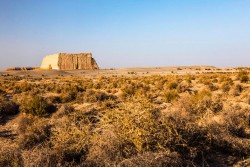You have no items in your shopping cart.


Introducing Yumen Pass
Yumen Pass, also known as Jade Gate or Pass of the Jade Gate, is the name of a pass located west of Dunhuang. In ancient times, this was a pass through which the Silk Road passed, and was the one road connecting Central Asia and China, the former called the Western Regions. Just to the south was the Yangguan pass, which was also an important point on the Silk Road.
Yumen Pass Fast Facts
• Chinese Name: Yumenguan 玉门关
• Best Time to Visit: May to October
• Recommended Visiting Hours: About 1 hour
• Things to Do: Photography, Hiking, Archaeology
• Opening Hours: 08:00-18:00
• Entrance Fee: ¥40
• Address: 90 km Northwest of Dunhuang, Jiuquan, Gansu Province
What to expect at Yumen Pass
"Travellers to ‘The Western Regions’ left China through the famous Yumenguan, or ‘Jade Gate Frontier-post,' named for the many jade caravans that passed through it. The original Jade Gate was erected by Emperor Wudi (Emperor Wu of Han) soon after 121 BCE and its ruins may still be seen about 80 kilometers (50 miles) to the northwest of Dunhuang which was, until the 6th century, the final outpost of Chinese territory for caravans on their long caravan journeys to India, Parthia, and the Roman Empire."
The remains of these two important Han-dynasty gates are about 68 kilometres (42 miles) apart, at either end of the Dunhuang extension of the Great Wall. Until the Tang dynasty, when the gates fell into disuse, all caravans travelling through Dunhuang were required to pass through one of these gates, then the westernmost passes of China. Yumenguan lies about 80 kilometres (50 miles) northwest of Dunhuang. It was originally called the ‘Square City,’ but because the great jade caravans from Khotan entered through its portals, it became known as the Jade Gate Pass. In the third and fourth centuries, turmoil swept through Central Asia, disrupting overland trade, and the sea route via India began to supplant it. By the sixth century, as caravans favored the northern route via Hami, the pass was abandoned. In 1907, Sir Aurel Stein found bamboo slips naming the site as Yumenguan, and in 1944 Chinese archaeologists discovered relics that confirmed this. With its 10-metre-high (32 foot) mud walls pierced by four gateways, the square enclosure covered more than 600 square metres (718 square yards) in the midst of unbounded desolation.
How to get to Yumen Pass
• Take a Tourist Bus from Dunhuang Hotel (North Section) to Yumen Pass. The bus stops at Dunhuang Tourist Center, Western Thousand Buddha Caves, Yanguan Pass, Yumen Pass and Yadan Geological Park. The bus departs at 08:30 every day. Visitors can book the tickets at Dunhuang Tourist Center, each Tourist Information Center in Dunhuang and the Tourist Hall of Singing Sand Dunes & Crescent Lake Scenic Area.
• Rent a vehicle to the pass is more convenient.
Additional travel advice on Yumen Pass
• Please prepare a scarf to cover your face in case there are sandstorms.
• Please wear sunscreen creams.